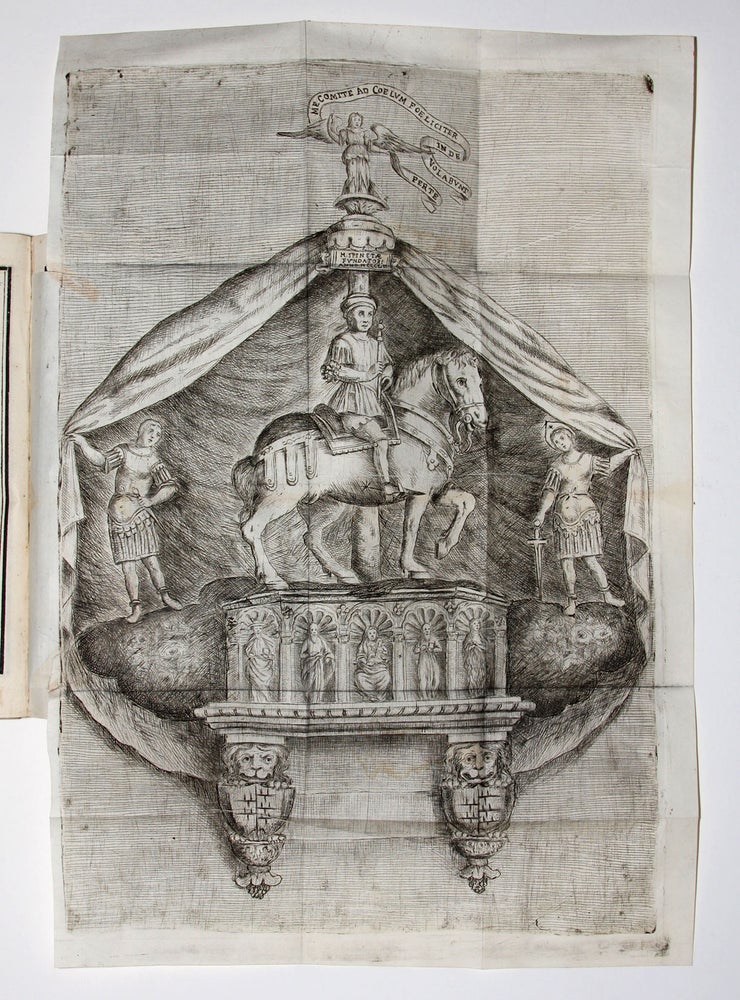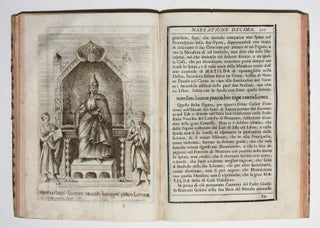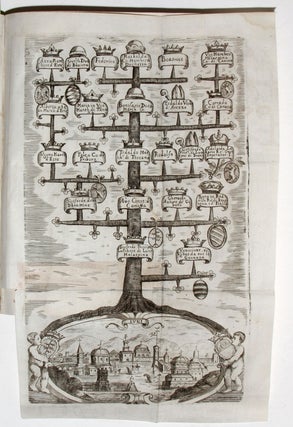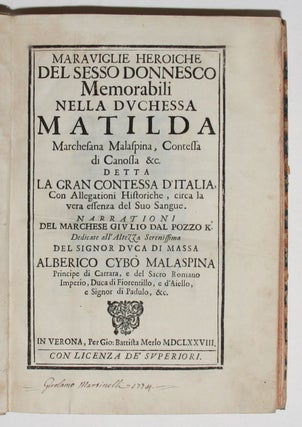Maraviglie heroiche del sesso donnesco Memorabili nella duchessa Matilda marchesana Malaspina, contessa di Canossa…detta la Gran contessa d’Italia.
Large 4to. [29 x 19.5 cm], (4) ff., 520 pp., 12 plates, of which 3 are large and folding, and with 1 half-page woodcut and 1 half-page engraving in text. With directions to binder tipped-in on rear endpaper. Bound in early quarter vellum and Carta Varese floral patterned boards, extremities somewhat rubbed. Very scattered occasional light spotting and one or two skillfully repaired closed tears to folding plates, without any missing surface. With a contemporary ownership inscription and date of Girolamo Martinelli, 1774 on the titlepage. Generally, a very clean and fresh copy. Rare first edition of this illustrated biography and genealogy of Matilda of Canossa, the medieval “sublime heroine” of papal fidelity, and one of the rare medieval women remembered for her military accomplishments. Intent on dispelling various misconceptions about her as well as honoring her kinsman Alberico Cybo Malaspina, to whom the work is dedicated, Pozzo provides a detailed narrative of Matilda’s life and family history. The plates, by Cesare Zambellini, include a portrait of Matilda, a fantastical depiction of her hilltop fortress at Canossa, and a rendering of an illustration in Donizone’s Vita Mathildis—a hagiographic biography by a local Canossan abbot written around the time of her death—which shows her wearing regal robes and seated on a throne, flanked by a monk presenting her with a book on one side and a soldier clutching a sword on the other. The present work also supplies a bibliography comprising over 150 authors, which includes four earlier biographies of Matilda published between 1587 and 1642. Pozzo refers to these frequently, noting in particular the aspects of Matilda’s history that these prior biographies do not cover. Matilda, exceptionally devout from an early age, would also become unusually powerful and influential. The sole surviving child of the Marquess Boniface of Tuscany and Beatrice, daughter of Frederick of Lorraine, she inherited extensive possessions in Middle and Upper Italy at age nine and undertook their administration when she was 25. This territory, which lay on the path between Germany and Rome, was of crucial importance in the political and ecclesiastical disputes of the time, literally and symbolically presenting a barrier between Henry IV of Germany and the papacy he was intent on bringing down. Throughout the conflict, which spanned the pontificates of Gregory VII, Victor III, Urban II, and Paschal II, Matilda provided substantial financial support and manpower to the papal cause. At her death in 1115, she bequeathed her territory to the Holy See, providing its first land holding outside of the Vatican and thus the foundation of the papal state. In the 17th century, Urban VIII, himself embroiled in conflicts with intractable European powers, revived Matilda’s story as a notable example of devotion to papal authority. As a mark of her importance, he commissioned Bernini to create a sumptuous tomb for her in 1633 that was placed prominently in St Peter’s. The present work, meticulously and painstakingly researched, made an important contribution to her renewed prominence, which dovetailed with the rise of significant female figures in the arts and public life, such as court composer Francesca Caccini, writers Maria Selvaggia Borghini and Margherita Costa, vocal proto-feminists such as Arcangela Tarabotti and the recently rediscovered Cecilia Ferrazzi. The volume carries on its title page the 1774 inscription of Girolamo Martinelli, a figure perhaps to be identified with the musician at that time considered to be “the best among the violoncellists” at the Cappella Musicale of San Marco in Venice (Boito, p. 201).
Sold






